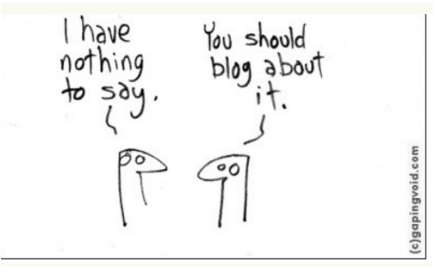By B.L. Ochman @whatsnext
Keep your copy lively, factual, tight, clear, short and linked to sources. Here are my blog writing guidelines: lessons I’ve learned blogging since 2002.
While basic writing talent is innate, many of the skills for writing compelling blog posts can be learned. Here are some guidelines I have gleaned from blogging since 2002.
These are my basic blog writing guidelines for creating posts that are readable and sharable:
Keep your copy lively, factual, tight, clear, short and linked to sources

Content creation tips
1. Be Interesting. Sounds simplistic, but most posts aren’t. And most posts don’t get read or shared because of that.
2. Inform, don’t sell. Blog posts are not sales sheets or ad platforms.
3. Share what you know. People like posts they can learn from. Don’t worry about giving away ideas. Those are a dime a dozen. People who can make ideas work are rare as hen’s teeth.
4. Learn from David Letterman: Make Top 10 lists. e.g., 8 Surefire Data Strategies for Fundraising Success; 7 Unbelievable Fundraising Letters
5. Use current sources. Don’t link to studies from 2009 in a post you write in 2015.
6. Include a call to action: Ask readers to do something, e.g., follow on Twitter, find out more about X, click to get the whitepaper.
7. How-to and how not-to posts are highly shareable
8. Select an interesting visual: A picture is worth a thousand words.
Make it compelling and be sure it will work well on a mobile device
9. Don’t take yourself too seriously. Blogging isn’t brain surgery..Don’t get pompous or dictatorial.

Blog writing & style tips
1. Write in a human voice and use first-person. If the post isn’t informing, inspiring, entertaining or making someone’s life better, you’re not done writing.
Stiff, formal writing is only for lawyers. And you know what Shakespeare said about them.
2. Select a compelling, catchy title: something that compels the reader to want to learn more.
3. Write short posts, short paragraphs, and lots of subheads. People who read blogs skim. Only someone with too much time on his/her hands will read a big, 2,000 word-long blob of copy. Write short, tight sentences and paragraphs. Too Long, Didn’t Read (TLDR) is your enemy.
4. Link, link, link. Don’t steal other people’s stuff. One thing that distinguishes blog posts from dead-tree journalism is that bloggers link prodigiously.
Link to any other blog or website you mention. Link to articles, books, products, bios, explanatory materials on other sites that you mention in your blog.
Always link to information that clarifies or gives background on information and opinions in your post.
5. Don’t use acronyms. Use the words the first time you mention a name or industry term. i.e. NonProfit Organization (NPO) and then use the abbreviation in the subsequent mentions. Don’t assume that everyone who reads what you write knows what you mean by acronyms.
6. Write less. Aim at keeping your posts to about 400 words. Keep sentences and paragraphs short. Use the simplest possible word and sentence structure. Omit all unnecessary content and words.
7. Use numbered or bulleted points whenever you can. Use subheads every few paragraphs, even in a 300-word post.
8. White space is your friend. It makes reading from the screen easier. Nothing is harder to read than a solid block of copy on a computer screen. Only 16% of people read every word online. Format your posts so that your main points stand out.
9. Forget what you learned about business writing in school if you graduated before 1990. Go ahead! Start sentences with “and” or “but.” Don’t be afraid to break archaic rules. But, jeez, follow all grammatical rules that provide clarity to your content.
10. Read your post out loud and make sure you don’t get stuck on complex construction. If you trip on a word the midst of reading a sentence aloud, re-write the sentence. Try the Hemingway app to help clarify your writing.
11. Do not over-use bold text emphasis on words and phrases. Bold text is appropriate as a topic point in lists, but not within a paragraph or list.
12. Writing takes time. Writing is about re-writing. Edit yourself. Use spellcheck.
Questions to ask yourself before you hit “Publish”:
__ Is the topic clear to someone who only reads the headline?
__Does the lead paragraph tell who and what the story is about and why the reader should care about it?
__ Is the angle you’ve used likely to seem newsworthy?
__Would someone who knows absolutely nothing about this topic understand this post?
__ Is the post free of jargon?
__ Does it make an effort to be objective?
Images: gapingvoid
Bonus Link: How to become a power blogger by Phil Szomszor
***
B.L. Ochman is a uniquely experienced digital pioneer who has been helping blue chip brands incorporate social media into their marketing strategy since 1996. She publishes What’s Next Blog, co-hosts and produces the award-winning Beyond Social Media Show podcast and contributes to AdAge DigitalNext. On Twitter, she’s @whatsnext.







